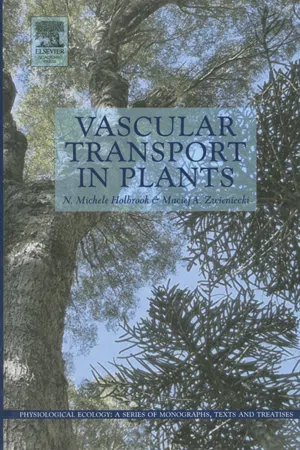
Vascular Transport in Plants
N. Michelle Holbrook,Maciej A. Zwieniecki
- 592 pages
- English
- ePUB (mobile friendly)
- Available on iOS & Android
Vascular Transport in Plants
N. Michelle Holbrook,Maciej A. Zwieniecki
About This Book
Vascular Transport in Plants provides an up-to-date synthesis of new research on the biology of long distance transport processes in plants. It is a valuable resource and reference for researchers and graduate level students in physiology, molecular biology, physiology, ecology, ecological physiology, development, and all applied disciplines related to agriculture, horticulture, forestry and biotechnology. The book considers long-distance transport from the perspective of molecular level processes to whole plant function, allowing readers to integrate information relating to vascular transport across multiple scales. The book is unique in presenting xylem and phloem transport processes in plants together in a comparative style that emphasizes the important interactions between these two parallel transport systems.
- Includes 105 exceptional figures
- Discusses xylem and phloem transport in a single volume, highlighting their interactions
- Syntheses of structure, function and biology of vascular transport by leading authorities
- Poses unsolved questions and stimulates future research
- Provides a new conceptual framework for vascular function in plants
Frequently asked questions
Information
Perspectives on the Biophysics of Xylem Transport
Publisher Summary
The Biophysics of Sap Ascent in the Xylem
Fundamentals of Cohesion-Tension Theory
The Etiology of an Embolism
Homogeneous Nucleation

Table of contents
- Cover image
- Title page
- Table of Contents
- Contributors
- Preface
- Acknowledgment
- Part I: Fundamentals of transport
- Part II: Transport attributes of leaves, roots, and fruits
- Part III: Integration of xylem and phloem
- Part IV: Development, structure, and function
- Part V: Limits to long distance transport
- Part VI: Evolution of transport tissues
- Part VII: Synthesis
- Index
- Physiological Ecology